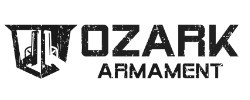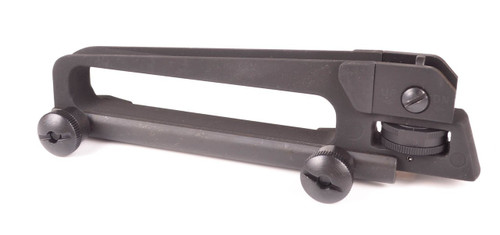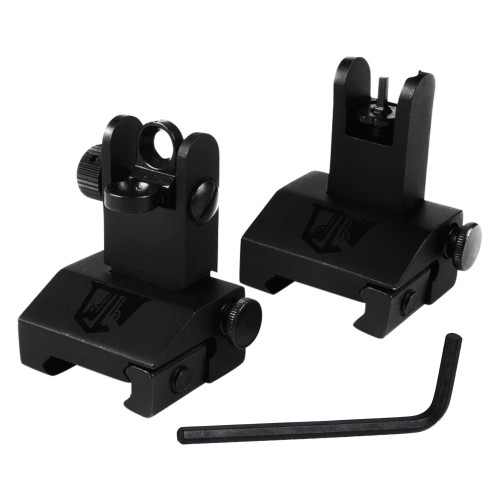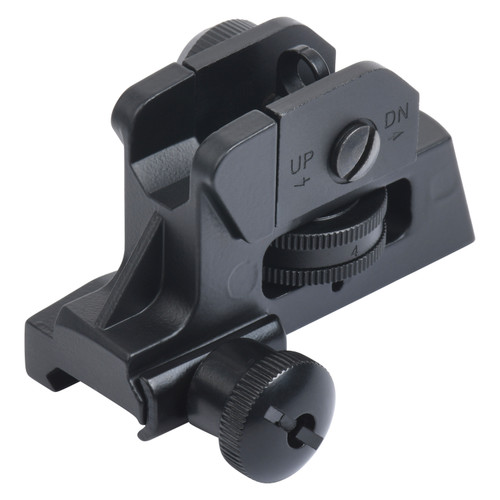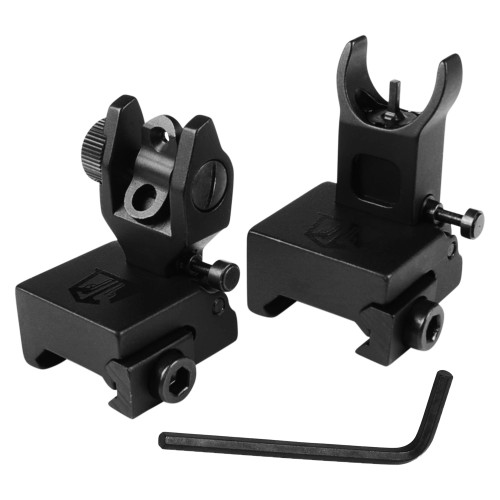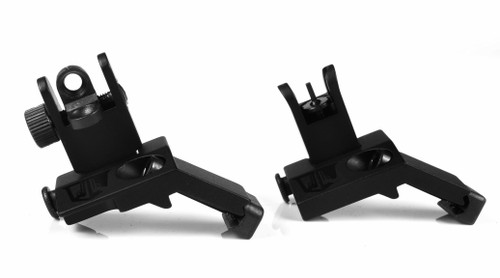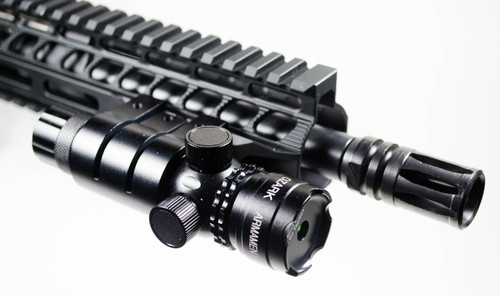Posted by Matt Rice on Mar 29th 2022
How to Clean Your Gun: Guide to Maintaining the Quality of Your Gun
SOURCES
- Introduction
- Recommended Maintenance
- Tools You Need
- Essential Gun Accessories You Need
- How to Clean Your Gun
Firearm Maintenance Made Simple: A Comprehensive Guide to Cleaning Your Gun
Your duties as a responsible gun owner extend well beyond locking up your gun and ammo when they’re not in use. Responsible gun ownership is about making sure your guns are safe.
That includes making sure your guns are safe to operate.
Think of it this way--your car needs regular maintenance, even if it seems to run smoothly when you drive to work each day. If left unattended, it will run smoothly until, suddenly, it fails, at which point minor concerns have long since festered into full-blown problems. The same is true of your gun.
Here are a few reasons why routine maintenance is essential for your gun.
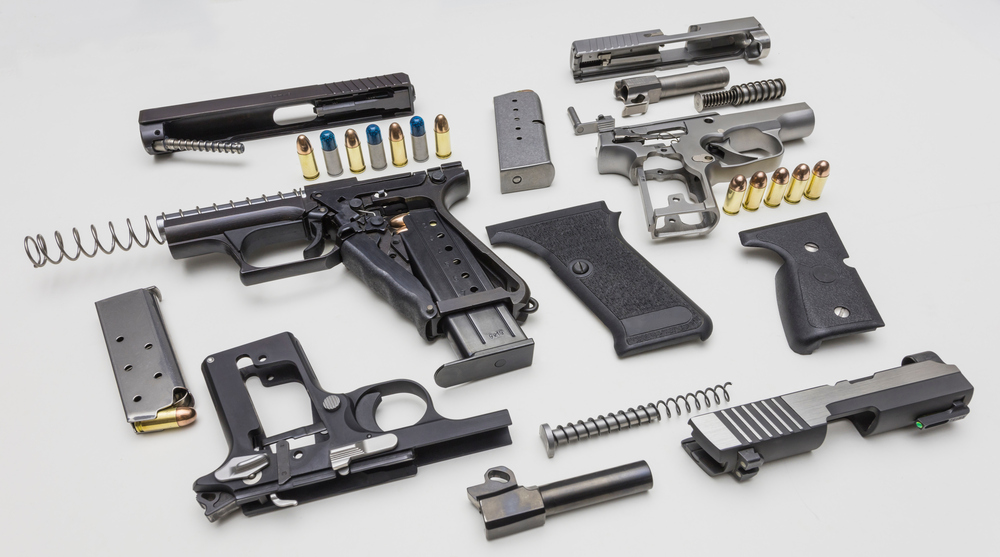
Be Familiar with Your Gun
First and foremost, regular maintenance helps you understand how your gun works. Whether you have a small handgun, a break-action trigger , a semi-automatic , or anything in between, knowing how your gun works is the first step to using it successfully.
You don’t need to be a mechanical wizard, but you should know how to disassemble and reassemble your gun. The simple act of taking it apart and putting it back together will help you understand what components go where and what each component contributes to your gun’s overall performance.
Remember, a gun is a machine. All of its parts work together toward one goal: propelling a round. From the outside, it looks like one complete unit, but the inside is far more complex. At a minimum, understanding how gun parts work together will help you understand what might be going wrong if your gun malfunctions.
Prevent Malfunctions
This brings us to the second point: without routine gun maintenance, malfunctions are a given. This includes things like:
-
Rusting
-
Failure to fire
-
Failure to feed
-
Failure to eject
-
Residual fouling buildup
For example, each bullet that passes through your gun creates fouling residue in the barrel. The residue from one bullet is no big deal, but residue built up over a hundred shots or more can affect your gun’s precision.
This relates to failure to fire, a common issue among guns that aren’t cleaned regularly. If your fouling residue builds up too much, the gun may fail to fire a round at all. It’s an annoyance on the range, but it can also be outright dangerous if the round explodes inside the gun.
The good news? All of these issues are avoidable with routine maintenance.
Increase Longevity
Ever hear stories of a gun passing from one generation to the next as a treasured possession? Ever look at a gun that fritzes out after a few years and wonder how that’s possible?
Simple: routine maintenance.
The one major difference between a gun that lasts generations and a gun that lasts a few years is maintenance. Much like your car or your teeth, your weapon will last longer if you take good care of it.
Think of it this way: your gun is designed to do one job. All of its parts have to work together to do that one job. It can complete that one job within a margin of error, but it’s always going to be better at its job if all its component parts function optimally. The more time you spend ensuring your gun functions optimally, the longer it will perform for you.
Recommended Maintenance
With that in mind, there are a few essential maintenance tasks that should be part of your regular checklist. We’ve narrowed it down to three: routine cleaning, dry firing, and weekly inspections.
Routine Cleaning
Routine cleaning is your desert island maintenance task. If you don’t do anything else for your gun’s health, you should always clean it. Always. Even if you haven’t used it at all, you should clean it anyway.
That’s because residue and deep corrosion can still build in your gun even if it sits in a safe untouched. The process is exacerbated if you carry your gun with you all the time, but it still happens.
Most gun owners don’t clean their gun after every use, or even every day. That’s perfectly fine--unless you’re firing a hundred rounds a day, you’re not going to accumulate that much residue between firings.
You should clean your gun after every 200 to 250 rounds, but failing that, try to cleaning it once every month or so. If you use your gun on a daily basis as a service weapon, you should clean it more often (even if you don’t fire) to ensure precision. Service weapon or not, keep in mind that the type of ammunition you use will affect how often you need to clean your gun.
Dry Practice
There’s a bit of debate around dry practice (i.e. practicing shooting techniques without live ammunition). We come down in favor of dry practice. Note that we use “dry practice”, not “dry fire”. There’s no firing, no loud noise, and no bullet holes. There are no bullets at all, actually, or even snap caps--the first step in dry practice is removing ammunition.
This alone makes dry practice safer than being on the range--you can’t shoot anything without any ammunition. But the practice itself is also an essential maintenance act for the gun owner. The one thing that will reliably help you hit your target is training, and dry practice gives you a chance to practice firing skills and safe gun handling.
By dry practicing, you get a chance to learn each firearm before going to the range. You can feel the trigger, its takedown, and how each function operates. You can test its firing capability without ammunition. That way, when you take the gun to the range, you won’t have any nasty surprises.
That said, some guns should not have their triggers snapped on an empty chamber, as this can damage the firing pin. This is most common in old-school single-action revolvers and rimfire guns.
Weekly Inspection
Finally, weekly inspection of your gun is an absolute must. Fortunately, this practice goes hand-in-hand with routine cleaning.
In the process of taking your gun apart to clean, you can check each of the individual components. This allows you to check for any signs of wear and tear or damage that might turn into a larger problem down the line.
Even if you don’t clean your gun on a weekly basis, it’s a good idea to take it apart and take stock. That way, you can spot any problems early.
Tools You Need
With that in mind, here are some of the essential tools you’ll need to clean your gun.
Cleaning Solvents
The magic begins with a great gun cleaning solvent. A solvent is simply a chemical that breaks down or dissolves other materials. A gun cleaning solvent is a simple solution that breaks down residue for easier cleaning. Don’t worry--it won’t do any harm to your gun as long as you use it in moderation.
There are two things to keep in mind: gun oil and cleaning solvents are not the same thing, and cleaning solvents need to be used in conjunction with cotton patches.
Gun oil and cleaning solvents are not interchangeable--they fulfill different purposes and are used at different stages in the cleaning process. You start with cleaning solvent and finish with gun oil. Moderation is key on both counts.

Gun Oil
Perhaps the most familiar cleaning tool for gun owners is gun oil. This is a specifically formulated type of oil containing additives that make it useful for cleaning firearms. The basic gun oil contains:
-
Isopropanol
-
Petroleum distillate or heptane
-
Viscosity modifiers
-
Antioxidants
-
Reducing agents
In much the same way oil lubricates your car engine, gun oil helps lubricate your gun and prevent rust.
Keep in mind that many general-purpose oils (and some budget gun oils) have a high slip coefficient. That’s fine for lubrication on cars or bikes, but it’s impractical for a firearm. Before you can ask: no, vegetable oil, WD-40, and transmission fluid are not sufficient replacements for gun oil. They’ll do more harm than good.
You need a well-formulated gun oil for the job, so don’t be shy about doing your homework.

Cleaning Rod
One of the most essential tools in your cleaning kit is your cleaning rod. This nifty little tool helps you clean inside hard-to-reach segments of your gun that still have residue buildup, like the barrel.
Most cleaning rods come in a few segments that are screwed together for the appropriate length based on your firearm. Picture the difference between cleaning a pistol and cleaning a shotgun and you’ll understand why.
Of all the options on the market, brass is usually strongest, but it’s also heavy. You can also find aluminum, fiberglass, and carbon fiber options.
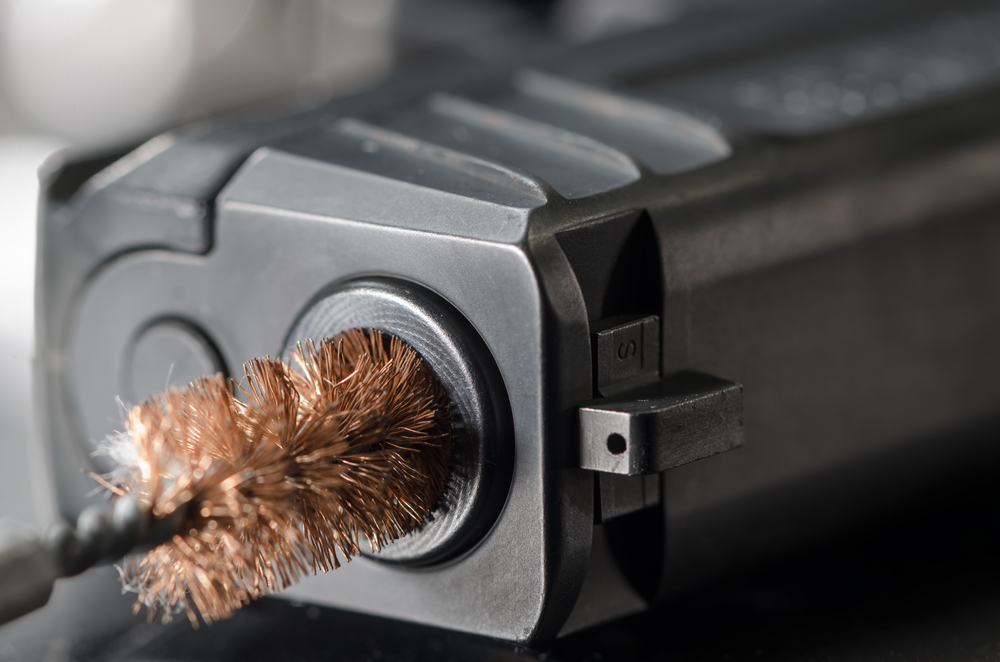
Bore Brush
Remember that pesky fouling residue we mentioned earlier? A bore brush is what you use to clean it out (once you attach it to your cleaning rod, that is).
You can find some universal bore brushes depending on how custom you want your cleaning kit to be, but most bore brushes are sold based on caliber. You’ll always get the best results if you use a bore brush matching your gun caliber.
Cotton Patches and Patch Holders
Cotton patches are like water: you’re always going to need it, so it’s a good idea to stock up. These are fantastic for cleaning your gun with solvent, but much like a drink of water, you only get it once. Sure, you could stretch it, but at that point, you’re just moving residue around.
Stock up on cotton patches. Stock up on a lot of them, especially if you clean your gun often.
As you can guess, patch holders and patches are like peanut butter and jelly. Like bore brushes, they attach to your cleaning rod, and like bore brushes, you should look for a patch holder made for your specific gun caliber.
Some gun owners opt for cleaning jags as an alternative to patch holders. This works like a pushing device for the patch holder, and you’ll need to buy one specific to each barrel you clean.
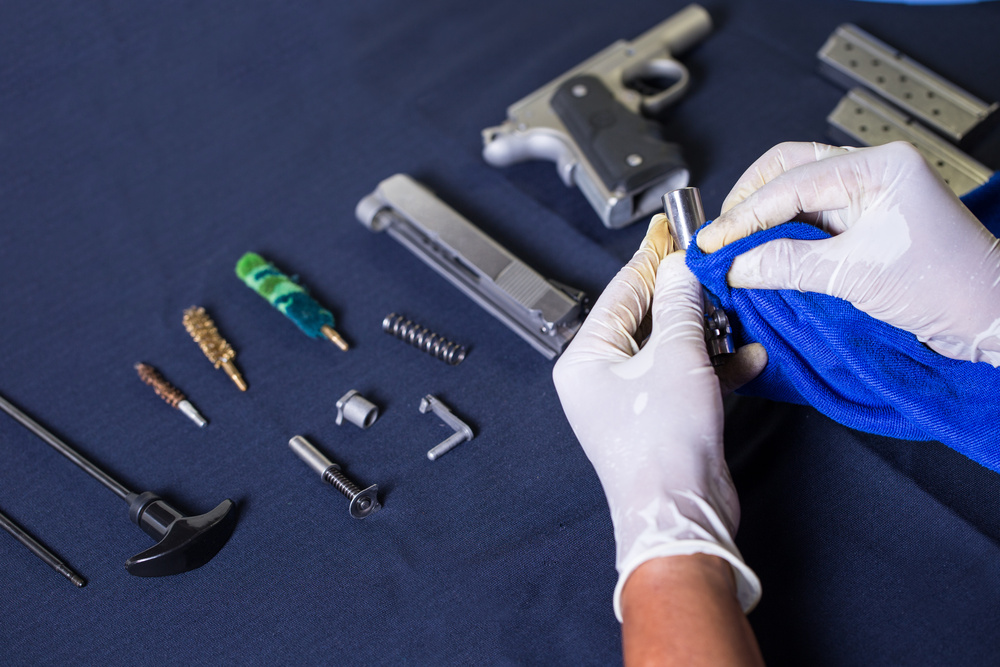
Luster Cloth
We’ve spent a lot of time talking about tools to clean inside the gun. A luster cloth is your go-to tool for the outside of the gun. As the name implies, this is the tool that restores luster to the gun’s exterior, removing fingerprints and stains so your gun looks its very best.
Unlike your average dishrag, a luster cloth is a type of cloth specially treated with a silicone lubricant. This makes it the perfect tool for wiping down the outside of your gun. Add a dab of gun oil and your luster cloth is ready for action.
Essential Gun Accessories You Need
Those are the essentials every gun owner needs. There are also accessories that make your life easier, depending on personal preference.
While some gun owners dedicate a table in the garage to gun cleaning and call it even, if you have a lot of advanced components to disassemble and reassemble, a gun mat may be a worthwhile investment. It’s a nonslip work surface that keeps everything in place while you work. Some even come with diagrams to help you keep track of every part.
Even if you don’t use a cleaning mat, it’s a good idea to have an organizer for all the separate parts as you disassemble your gun. This is an essential element to set up your workstation before you start cleaning to avoid confusion (especially when dealing with the number of small parts in a handgun).
Another good investment for any gun owner is a muzzle guard, which protects the muzzle crown from unnecessary damage and keeps the cleaning rod aligned.
Many gun owners also find it useful to keep drip pans handy when cleaning their guns. You won’t use that much solvent and gun oil during each cleaning, but a drip pan will help you in case of any accidents.
Ultimately, though, what you use beyond the basics is up to you--just try to look for supplies based on your specific caliber. Many cleaning kits are sold this way, so you can get everything you need in one pre-organized container.
How to Clean Your Gun
Once you have all your tools on hand, you’re ready to give your gun a proper cleaning. Here’s a quick review of how to do it.
Prepare
Preparation is the key to success, so before you break out your gun oil and bore brush, take some time to prepare your workspace.
Ideally, you should have a dedicated workspace for cleaning your guns. You should plan to be there at least every two weeks or so to tinker with your guns, even if you’re not cleaning them (unless you don’t use your gun often, in which case you should clean it every month or so). Pick a spot with enough space and excellent lighting.
The cleaner your space, the more likely you are to use it (in translation: the more likely you are to clean your gun). Everything should have a place and everything should be in its place. This will make it easy to see if you need to replace anything before you get started.
Remove All Ammunition
Once your work area is ready, remove all ammunition. Not just from the gun, but from the whole room. Then double-check and re-check a third time for safety’s sake.
Always keep in mind that a gun is a weapon. Treating it with the deference it deserves is the only way to be a safe, responsible gun owner.
Break Out the Manual
Finally, make sure to dust off your owner’s manual and set it out before you get started.
Experienced gun owners may scoff at the owner’s manual, but it’s useful for a new gun you’re not yet familiar with. The owner’s manual tells you how to work with each gun safely. Plus, if you run into an unexpected problem, chances are the manual may have the answer.
Cleaning the Gun
Now for the main event: cleaning the gun. You should plan to spend at least half an hour thoroughly taking apart, examining, and cleaning each individual gun.
Start by disassembling your gun, in part or in full. This will give you a collection of small parts--put them in their designated place rather than just setting them aside.
From there, use a dry brush to clean the barrel of your gun. This removes any metal shavings and carbon. Break out your cotton pad and some cleaning solvent to clean the barrel, pushing the pad all the way out to the other side of the barrel. Do this repeatedly until the patch comes clean (you may need to replace the patch a few times).
Next, clean the exterior using lubricant and fresh cleaning pads. When you get to the action, use a solvent and a utility brush. Let the excess go into the drip pan and let it dry in full before reassembling.
You should also clean your gun magazine as part of this process. It may be helpful to have a secondary workspace for this task (the further from the gun, the better). Fully empty and disassemble the magazine before cleaning. Take extra care with spring-loaded magazines.
Reassemble and Test
Last but not least, you’re ready to carefully reassemble the gun (minus the ammunition). Perform a test check, or dry practice, to make sure everything is in working order before loading the ammunition.
Reference:
A Beginner’s Guide On Gun Maintenance
. (2020, July 7). American Gun Association.
https://blog.gunassociation.org/beginners-guide-on-gun-maintenance/
Davis, L. (2020, August 5). Gun Maintenance: How to Take Care of Your Firearms.
Lives On
.
https://www.liveson.org/gun-maintenance-how-to-take-care-of-your-firearms/
NRA Family Staff. (2019, December 30).
How to Clean Your Gun
. NRA Family.
https://www.nrafamily.org/articles/2019/12/30/how-to-clean-your-gun/
NRA Staff. (n.d.).
How Do Guns Work? Semi-Automatic (Self-Loading) Mechanisms
[2021 January 20]. NRA Family. Retrieved March 22, 2021, from
https://www.nrafamily.org/articles/2021/1/20/how-do-guns-work-semi-automatic-self-loading-mechanisms
NRA Staff. (2021, February 25).
How Do Guns Work? Break-Action & Double-Barrel Triggers
. NRA Family.
https://www.nrafamily.org/articles/2021/2/25/how-do-guns-work-break-action-double-barrel-triggers
Texas Parks & Wildlife Department. (n.d.).
Firearms Cleaning and Maintenance
. Texas Parks & Wildlife Department. Retrieved March 22, 2021, from
https://tpwd.texas.gov/education/hunter-education/online-course/firearms-and-ammunition-1/cleaning-and-maintenance
Why Dry Firing Your Firearm Is a Great Idea and How It’s Done
. (2019, March 4). American Gun Association.
https://blog.gunassociation.org/why-dry-firing-your-firearm-is-a-great-idea-and-how-its-done/
Wilson, J. (2020, November 23).
Is It Safe to Dry-Fire Your Gun?
NRA Family.
https://www.nrafamily.org/articles/2020/11/23/is-it-safe-to-dry-fire-your-gu
Article Written By Matt Rice, Owner Operator of OZARK ARMAMENT
Matt Rice is the founder and owner operator of OZARK ARMAMENT. He started the company in 2016 with a vision to bring quality, affordable firearm accessories to every person who wants to improve their shooting experience. With his dedication to providing old-school customer service and his attention to detail in the development and manufacturing of gear, Matt has helped OZARK ARMAMENT become a respected name in the firearm accessories industry.
{ "@context": "https://schema.org/", "@type": "Person", "name": "Matt Rice", "url": "https://www.ozarkarmament.com/", "sameAs": [ "https://www.facebook.com/matt.rice.5832/", "https://www.instagram.com/ozarkarmament/" ], "jobTitle": "Owner Operator", "worksFor": { "@type": "Organization", "name": "OZARK ARMAMENT", "url": "https://www.ozarkarmament.com/" } }
